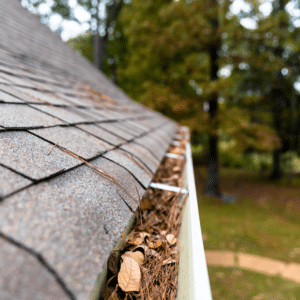Preparing your homes roof for wildfire season is crucial to protect your property from potential damage. One of the most effective ways to do this is by eliminating your roof debris. Additional key steps can significantly reduce the risk of fire spreading through your roof.
To further prepare your homes roof for wildfire season, consider retrofitting your roof with fire-resistant coatings or foams. Fire retardant treatments can offer additional protection to existing roofing materials. Ensure adequate ventilation of attic spaces to prevent heat buildup and maintain your soffit and fascia boards as they are integral to your roof’s fire resistance. Regular inspections by a roofing professional can also identify potential weak spots that could be susceptible to ember attacks.
Understanding the Threat of Wildfires on Your Homes Roof
Wildfires pose a significant threat to homes, with roofs being particularly vulnerable to fire damage. Inadequate roof preparation can lead to devastating consequences, as exemplified by a home that was lost during a wildfire. It is crucial to understand the risks and take proactive steps to protect your homes roof. Measures such as using fire-resistant materials, ensuring proper ventilation, and conducting regular inspections can greatly enhance a roof’s resistance to wildfires, safeguarding your home and loved ones. By recognizing the dangers and taking necessary precautions, homeowners can mitigate the risks associated with wildfires and fortify their roofs for optimal protection.
The Overlooked Steps in Homes Roof Preparation
Preparing a homes roof for wildfire season involves taking essential steps that are sometimes overlooked. These overlooked measures can greatly enhance the roof’s resilience and improve its ability to withstand wildfires. Retrofitting the roof with fire-resistant coatings or foams is a powerful and often underutilized step that adds an extra layer of protection. Adequate ventilation in the attic space is crucial, as it helps regulate temperature and prevents heat buildup that could lead to roof ignition. Neglecting the maintenance of soffit and fascia boards can leave the roof vulnerable to ember intrusion, making it vital to ensure their upkeep. Regular inspections by professional roofing contractors play a significant role in identifying potential weaknesses before they escalate into major problems.
Making Your Roof Ember Resistant
Making your roof ember resistant is crucial for protecting your home from wildfires. Embers pose a significant risk as they can ignite roofs and other combustible materials. To prevent ember intrusion and ignition, several measures can be taken. Installing spark-resistant vents creates a barrier that blocks embers from entering the attic space, reducing the risk of fire spread within the roof structure. Using fire-resistant materials for eaves and overhangs, such as metal or cementitious siding, minimizes the potential for embers to ignite these vulnerable areas. Ember-resistant skylights, equipped with features like tempered glass and ember screens, prevent ember intrusion and reinforce the roof’s defenses.
Real-life cases demonstrate the effectiveness of these measures, as homes equipped with ember-resistant features survived nearby wildfires while neighboring homes suffered damage. By understanding the role of embers and implementing these proactive measures, homeowners can significantly reduce the risk of roof fires during wildfires. These measures provide essential protection for the home, enhancing its resilience and increasing its chances of withstanding ember attacks.
Additional Measures to Increase Roof Fire Resistance
In addition to the essential steps mentioned earlier, there are advanced measures that homeowners can consider to further increase their roof’s fire resistance. These additional measures provide an extra layer of protection against wildfires and can significantly reduce the risk of fire damage to the roof and the entire home.
Fire-resistant underlays are one such advanced measure. These underlays are installed beneath the roof covering, acting as a secondary barrier against ember penetration. They are specifically designed to resist flames and embers, preventing them from reaching the underlying roof structure. Fire-resistant underlays help minimize the risk of ignition and provide additional time for fire suppression measures to be effective.
Another advanced measure is the installation of roof sprinkler systems. These systems are designed to actively suppress fires by spraying water or fire retardant onto the roof surface when triggered. They can be activated either automatically by heat sensors or manually controlled by the homeowner or emergency responders. Roof sprinkler systems are particularly effective in the early stages of a wildfire, when small embers or sparks may be present on the roof. By quickly extinguishing these potential fire sources, they help prevent fire spread and protect the home.
It is important to note that the installation of fire-resistant underlays and roof sprinkler systems should be carried out by professionals experienced in wildfire mitigation. Consulting with a qualified roofing contractor or wildfire mitigation specialist is recommended to ensure proper installation and adherence to local building codes and regulations.
Additionally, a successful story of a homeowner who utilized these advanced measures, saving their home from a catastrophic wildfire, stands as solid proof of their efficiency. Utilizing these measures in roof preparation can substantially bolster a homes durability, providing an enhanced defense during the wildfire season.
Professional Inspection and Maintenance
Partnering with experienced roofing contractors like Just Roofs and Gutters, homeowners can benefit from their expertise and thorough assessments, addressing any potential fire hazards and enhancing their roof’s ability to protect against wildfires. While homeowners can take several proactive steps, a thorough examination by a professional roofing contractor ensures that no vulnerabilities are overlooked.
During a professional inspection, roofing contractors look for various signs of vulnerability. This includes assessing the condition of shingles or roofing materials for damage or deterioration. Damaged or missing shingles can create openings that allow embers to infiltrate the roof, increasing the risk of ignition. Additionally, compromised seals around vents, chimneys, or other roof penetrations are examined, as these areas are prone to ember intrusion. Proper seals are crucial in preventing ember entry and subsequent fire incidents.
Furthermore, the inspection focuses on identifying signs of deterioration or wear and tear that may compromise the roof’s fire resistance. This includes checking for signs of aging, such as cracking, warping, or excessive granule loss in asphalt shingles, which can reduce their effectiveness against fire hazards.
Why is it important to prepare your homes roof for wildfire season?
Preparing your homes roof for wildfire season is crucial because roofs are particularly vulnerable to fire damage during wildfires. Embers can travel long distances and ignite roofs, leading to the destruction of homes. By implementing the key steps outlined in this article, such as retrofitting with fire-resistant materials, ensuring proper ventilation, and conducting regular inspections, you can significantly enhance your roof’s ability to withstand potential fire threats, safeguarding your home and providing valuable protection during wildfire season.
Protecting your homes roof from wildfires requires proactive planning and implementation of fire-resistant measures. Take action today to protect your home and community from the threat of wildfires. Schedule a roof inspection with Just Roofs and Gutters to assist and guide you.





